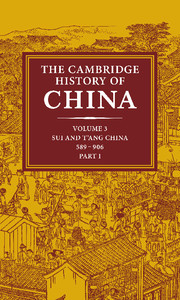Book contents
- Frontmatter
- 1 Introduction
- 2 The Sui dynasty (581–617)
- 3 The founding of the T'ang dynasty: Kao-tsu (reign 618–26)
- 4 T'ai-tsung (reign 626–49) the consolidator
- 5 Kao-tsung (reign 649–83) and the empress Wu: the inheritor and the usurper
- 6 The reigns of the empress Wu, Chung-tsung and Jui-tsung (684–712)
- 7 Hsüan-tsung (reign 712–56)
- 8 Court and province in mid- and late T'ang
- 9 Court politics in late T'ang times
- 10 The end of the T'ang
- Glossary Index
- References
7 - Hsüan-tsung (reign 712–56)
Published online by Cambridge University Press: 28 March 2008
- Frontmatter
- 1 Introduction
- 2 The Sui dynasty (581–617)
- 3 The founding of the T'ang dynasty: Kao-tsu (reign 618–26)
- 4 T'ai-tsung (reign 626–49) the consolidator
- 5 Kao-tsung (reign 649–83) and the empress Wu: the inheritor and the usurper
- 6 The reigns of the empress Wu, Chung-tsung and Jui-tsung (684–712)
- 7 Hsüan-tsung (reign 712–56)
- 8 Court and province in mid- and late T'ang
- 9 Court politics in late T'ang times
- 10 The end of the T'ang
- Glossary Index
- References
Summary
The emperor Hsüan-tsung, longest-reigning of all the T'ang monarchs, was an immensely capable ruler, who restored his dynasty to a new peak of power after decades of usurpation, weakened authority and corruption. To the Chinese living through the troubled and disturbed decades which followed his abdication, his reign represented a golden age of departed glories, an era of good government, peace and prosperity, equally successful at home and abroad. Yet his reign ended in tragedy, and in disasters largely resulting from his own actions and policies which almost destroyed the dynasty. To the historians who wrote the record of his reign in the late 750s he was a tragic hero, whose reign had begun in splendour, but who had later been led astray by ambition and hubris into overstraining his empire's administration and resources, and who then completed its ruin by withdrawal from active participation in its government.
All were agreed, however, that he was a ruler out of the ordinary, who left his indelible print upon the history of his times. He was, moreover, a man of many parts, a skilled musician, a poet, a good calligrapher, patron of many artists and writers. He was also deeply versed in Taoist philosophy, of which he became a major patron, and – in spite of his early measures against the Buddhist establishment – later became deeply involved in Esoteric Buddhism. As a person he seems to have enjoyed deep friendship with his brothers and family members, and even the formal records of his reign portray a man of great personal warmth, close attachment to his advisers, directness and passion.
- Type
- Chapter
- Information
- The Cambridge History of China , pp. 333 - 463Publisher: Cambridge University PressPrint publication year: 1979



